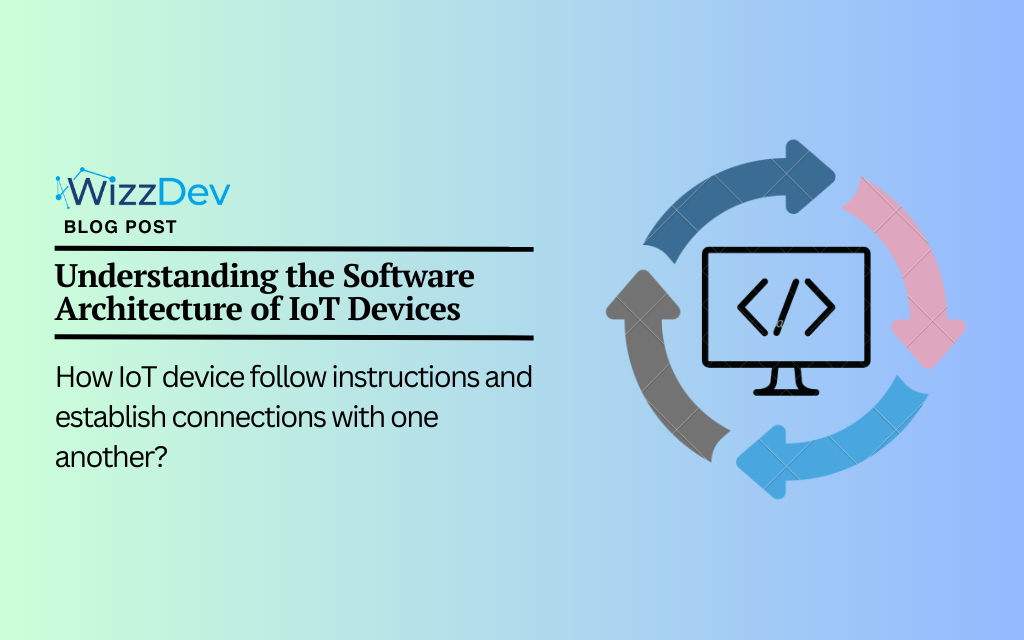The Internet of Things (IoT) encompasses the vast majority of the technology we use today, from our living rooms to our offices to our skin. Because of IoT, we now do things differently. This is due to the software powering these gadgets, which follow instructions and establish connections with one another.
It’s crucial to understand the software powering these gadgets as it sheds light on their abilities and how they relate to other tools. The software acts as instructions for the gadgets, facilitating communication between them and ensuring they carry out necessary tasks.
This article focuses on IoT software, dissecting the program and examining how it works from top to bottom. We’ll also learn the significance of each component. If you’re interested in technology, work with technology, or simply want to learn more about the inner workings of smart gadgets, this post will help you better comprehend IoT software. Let’s get started!
What is Software Architecture?
Understanding what we mean by software architecture is crucial before we go into the complexities of IoT devices. Software architecture, at its most fundamental level, is the overall design of a program or system. It is the plan for the entire system or undertaking, outlining the connections between individual pieces of software.
When we talk about a program’s or application’s architecture, we’re talking about more than just the code that was written to make it. It consists of the software’s parts, their outwardly apparent characteristics, and the connections between them. It’s the blueprint for making sure every component of a program works together to provide the expected results.
Software design becomes increasingly crucial in the Internet of Things. IoT devices frequently need to sense data, communicate with other devices, process information, and take action all at once. An IoT device’s software design needs to be sturdy and adaptable enough to successfully manage all these activities, guaranteeing the device’s consistent performance even when faced with unexpected challenges.
We’ll examine the fundamental building blocks of IoT software architecture and how they interact with one another to bring an IoT device to life in the following sections.
Key Components of IoT Software Architecture
IoT software architecture has 4 main layers: Device, Network, Management, and Application. These 4 layers work together to create a seamless IoT system.

Deep Dive into the Device Layer
The Device Layer is the foundation of an IoT system, comprising physical devices that gather data and perform actions. These include sensors, which collect data such as temperature, light, and motion, and actuators, which perform actions like adjusting thermostats and turning on lights.
Device-level software and firmware also play a crucial role. They manage device resources, communicate with other parts of the IoT system, and provide low-level control for hardware.
The Device Layer is vital as it’s the point where digital and physical worlds interact. Device-level software must be efficient and reliable, accurately collecting data from sensors, managing resources, and communicating with the rest of the IoT system. This must be done within the constraints of the device’s limited processing power, memory, and energy resources.
Exploring the Network Layer
The Network Layer is responsible for transmitting data collected at the Device Layer to other parts of the IoT system for processing and analysis. It uses various communication protocols such as MQTT, CoAP, and HTTP to format, address, transmit, and receive data over a network. These protocols are chosen based on the specific requirements of the IoT system. Technologies for data transmission, such as Wi-Fi, Bluetooth, Zigbee, and cellular networks, are also involved. The Network Layer ensures reliable and efficient transmission of data from devices to servers, enabling the IoT system to function as a cohesive unit.
Understanding the Management Layer
As IoT systems become more complex, managing the devices and their data becomes a challenge. The Management Layer oversees device operation, connectivity, and data storage. It manages device configuration and updates, tracks device status, and stores and retrieves data. Security measures are implemented to protect the system from threats. The Management Layer also optimizes system performance and resource management.
Navigating the Application Layer
The Application Layer is the final layer in our IoT software architecture. Here, data from IoT devices is processed, analyzed, and turned into actionable insights, while also providing the user interface. This layer is crucial because it extracts meaningful insights from raw data and provides users with tools to interact with the IoT system. The user interface could be a mobile app, web dashboard, or API that allows third-party services to integrate with the IoT system. The Application Layer also involves cloud-based servers for data storage and analytics, and edge computing techniques to process data closer to the source, reducing latency and bandwidth usage. Ultimately, the Application Layer brings the entire IoT system together to enable smarter, more efficient operations through data-driven decision-making.
The Role of Middleware in IoT Software Architecture
In IoT, middleware connects networked devices to applications, allowing them to communicate and share data. It simplifies application development by providing a uniform way to interact with different hardware, protocols, and data formats.
Middleware performs several critical functions, including device discovery, data filtering and aggregation, communication abstraction, and event handling. With middleware, developers can focus on the application logic without worrying about the underlying hardware or network protocols.
Middleware can manage heterogeneity in IoT systems, which often have many devices with different capabilities and protocols. By providing a common interface for interaction, middleware simplifies integrating diverse devices into an IoT system.
Importance of Security in IoT Software Architecture
Security is crucial in IoT software architecture due to the interconnected nature of IoT systems, which makes them more vulnerable to cyber-attacks such as eavesdropping, data manipulation, and denial of service attacks. Since IoT devices often collect sensitive data and control critical systems, a security breach could have serious consequences.
IoT software architecture includes device security, network security, and data security. Device security involves protecting the physical device and its software from tampering using secure boot mechanisms, hardware encryption modules, and tamper-proof enclosures. Network security involves securing communication between devices and servers using encrypted data in transit, secure communication protocols, firewalls, and intrusion detection systems. Data security involves protecting the data collected and processed by the IoT system by encrypting the data at rest, implementing access controls, and ensuring that data is stored and processed in compliance with relevant data protection regulations.
Security should be a primary consideration from the earliest stages of designing an IoT system and should be integrated into every layer of the IoT software architecture using a security-by-design approach. This will enable the building of robust IoT systems that are capable of protecting sensitive data from threats.
IoT architecture comprises several layers, each with a unique role. The Device Layer interacts with the physical world, the Network Layer ensures seamless communication, the Management Layer oversees operations and security, and the Application Layer transforms raw data into actionable insights. Designing effective IoT software architecture is challenging. It requires a deep understanding of specific requirements and the broader technological landscape. Challenges include managing vast amounts of data, ensuring system security, optimizing performance, and providing a user-friendly interface. Despite these challenges, IoT is rapidly advancing. Emerging trends such as edge computing, AI, machine learning, and 5G are reshaping IoT software architecture. Understanding IoT software architecture is crucial for IoT system design, development, and use. It provides a framework for thinking and navigating the complex technological landscape.
Whether you’re a developer, a decision-maker, or a curious mind, we hope this exploration of IoT software architecture has been enlightening. Stay tuned for more deep dives into the fascinating world of IoT!










